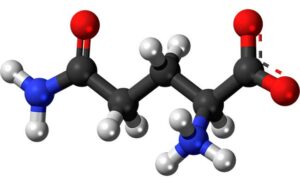
Amino acids can form strong chelated complexes with divalent metal ions. The stability of these complexes changes in the following sequence: Cu2+ > Ni2+ > Zn2+ > Co2+ > Fe2+ > Mn2+ > Mg2+ (Smirnov V.A., Klimochkin Yu.N., 2007). Their ability to form complexes facilitates the absorption of microelements such as Cu2+, Zn2+, Fe2+, and others from the intestine into the bloodstream. Amino acids provide nutritional effects (of minimal significance when exogenously introduced into the body) and regulatory effects, while metal ions offer catalytic (in relation to peptides and amino acids) and specific micronutrient effects. Chelated compounds are found in many combined sports nutrition products, and their quantities vary widely (Karkishchenko N.N. et al., 2014).

From the perspective of sports nutrition, the regular intake of each chelated amino acid compound serves several purposes: firstly, it enhances bioavailability (absorption, transport, utilization by organs and tissues) of amino acids or peptides and reduces their minimum effective dosage to achieve the final metabolic outcome. Secondly, it increases the physicochemical stability of the consumed product. Thirdly, it prevents micronutrient deficiencies (by improving the absorption of trace elements through binding to proteins). Finally, it boosts the anabolic properties of peptides and amino acids (Connolly P., 2013).
The company “Albion” has developed a range of chelated forms of amino acids with diverse properties, attributed to both metals and organic compounds. From a sports nutrition perspective, the greatest potential applications may be observed with chelated forms such as magnesium bisglycinate (known for its anabolic action on skeletal muscles), iron bisglycinate (useful in cases of iron deficiency), and glycyl-L-glutamine-magnesium chelate (an integral component of combined products for muscle recovery and growth, often used with nutrabolics). However, there is currently limited clinical data on the effectiveness of these substances and their mechanisms of influence on the body during physical exertion.
The chelated magnesium complex L-glutamine – Mg-glycyl-L-glutamine (MgGG), considered a promising direction in sports medicine, exhibits high stability in aqueous solution and rapid absorption in the intestine after oral ingestion, increasing the concentration of free L-glutamine in the blood plasma within 30 minutes (Bynum S., 2000). It is believed that the magnesium ion in the form of a chelated compound with glycine and L-glutamine not only stabilizes the resulting substance but also reduces adverse effects on the gastrointestinal tract, promotes absorption, and enhances the bioavailability of amino acids.
Even small amounts of L-glutamine (240 mg) included in the chelated magnesium compound have a pronounced stimulating effect on the absorption of this amino acid in the intestine. In a study comparing the effect on lean body mass and several blood biochemical parameters of daily oral intake of 400 mg of glycyl-glutamine chelate (MgGG, chelate group, n = 11) and a prohibited anabolic steroid testosterone at a dose of 2000 μg (steroid group, n = 12) over 56 days in healthy volunteers under conditions of daily training of specific intensity and duration, it was observed that the increase in lean body mass over 56 days in the chelate group was 3.2 kg, slightly higher than the 3.0 kg in the steroid group. Additionally, in the chelate group, there were no changes in blood pressure, cholesterol levels, HDL cholesterol, or triglycerides, whereas in the testosterone group, these indicators were elevated, indicating the development of metabolic disorders in the cardiovascular system. These results suggest that the inclusion of relatively small amounts of glycyl-L-glutamine (240 mg as glutamine equivalent) in a single magnesium chelate complex is accompanied by a synergistic increase in the positive effects of L-glutamine on lean body mass, equal to or even exceeding the effect of 2 mg daily testosterone but without the side effects associated with steroids and long-term risks. Therefore, MgGG may represent a viable non-doping alternative to steroids in terms of its positive impact on lean body mass and, consequently, overall physical performance.
Glutathione is a tripeptide composed of the amino acid residues glutamate, cysteine, and glycine (γ-L-glutamyl-L-cysteinylglycine) primarily synthesized in liver cells. Its reserves in oxidized or reduced forms are stored in all cells of the body. Glutathione participates in various metabolic processes, with a particular emphasis on its well-established antioxidant and detoxification functions (Tedeschi M. et al., 1990; Meister A., 1994), which have been further substantiated at a new methodological level (Zhang Y., et al., 2018), including by one of the authors of this book through real-time research on erythrocyte cell membranes in qualified athletes (Gunina L., 2015; Gunina L.M., 2015; Gunina Larisa, 2016; Gunina L.M. et al., 2016).
The mechanisms underlying these functions are detailed in relevant human biochemistry guides. Inside cells, glutathione reduces the formation of disulfide bonds in cytoplasmic proteins containing cysteine, serving as an electron donor. During this process, glutathione is converted into its oxidized form, glutathione disulfide (GSSG). Subsequently, glutathione can be reduced back to GSH with the help of glutathione reductase. Glutathione is not an essential nutrient as it is synthesized within the body.
From the perspective of sports biochemistry and physiology theory, when taken orally, glutathione as an exogenous pharmaconutrient should support immunity, aid in toxin removal, enhance resistance to physical stress, and reduce oxidative stress. Most sports nutrition product manufacturers position it this way; however, this positioning lacks sufficient clinical research to validate its claims. There is a dearth of publications from the standpoint of evidence-based medicine, especially considering the extended presence of various glutathione forms in the market.

Physical exertion decreases the concentration of reduced glutathione and increases the amount of oxidized glutathione form (Gambelunghe C. et al., 2001). As the duration of training exceeds a certain threshold, a reduction in glutathione concentrations in the blood plasma and tissues is observed (Lew H. et al., 1985; Pyke S. et al., 1986; Georgakouli K. et al., 2017). This underscores the connection between the glutathione system and aerobic energy metabolism and the process of muscle contraction. It is unquestionable that in such conditions, an increase in intracellular glutathione content is a necessary factor in enhancing the athlete’s body’s resistance to prolonged intense exertion (Zalavras A. et al., 2015). However, a key question remains unanswered: how effective is exogenous oral glutathione consumption? Does it genuinely increase glutathione concentration within skeletal muscle cells, the brain, and other organs, or does glutathione disintegrate into individual amino acids in the gut, making it more sensible to use those instead? Some argue that N-acetylcysteine is a more effective and cost-efficient alternative to glutathione. These issues were comprehensively addressed 13 years ago in the work of C. Kerksick & D. Willoughby (2005) concerning the mechanisms and practical application of glutathione and N-acetylcysteine in sports practice. However, discussions on this topic persist to this day.
In 2014, J. Kovacs-Nolan and colleagues demonstrated, using in vitro and in vivo models, that glutathione can be transported across intestinal epithelial cells in an unchanged form, and this process is proton-dependent. The entry of glutathione into cells is rapid, with the tripeptide being detected in the intestinal wall within 60 minutes. In vivo research showed that after oral intake, glutathione rapidly oxidizes and accumulates in red blood cells and liver cells, with small amounts remaining in the plasma. The authors concluded that oral glutathione intake is an effective way to enhance systemic antioxidant protection and increase the body’s resilience to oxidative stress. Additionally, E.Y. Park and colleagues (2014) demonstrated, in a study on healthy volunteers, that after oral intake of glutathione at a dose of 50 mg/kg-1, there was a transient and significant increase in the concentration of this tripeptide in the blood plasma within 60–120 minutes, specifically in its protein-bound form, not the free form. These findings unequivocally indicate glutathione’s ability to penetrate in an unchanged form through the intestinal mucosa, tissue cell barriers, and replenish endogenous tripeptide stores within the overall antioxidant defense system.
The mentioned research provides intriguing prospects for the clinical use of glutathione when taken orally, especially in the context of sports nutrition and physical activity.
Let’s further examine the key conclusions and findings from these studies:
In summary, glutathione represents an interesting prospect in improving physical activity and aerobic metabolism, and further research can expand our understanding of its role and effectiveness in this domain.